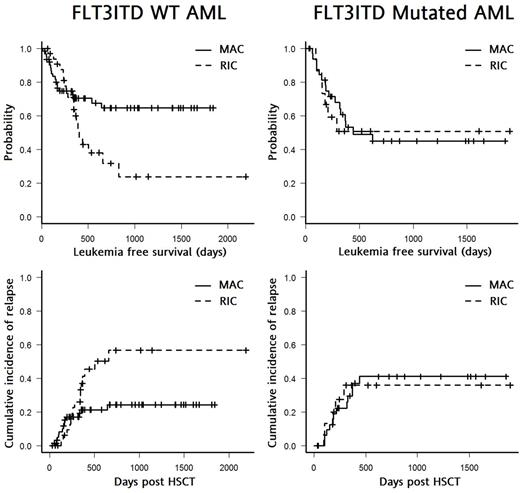Abstract
AML with FLT3 -internal tandem duplication mutation (FLT3-ITD) has a very high relapse rate when patients were treated with chemotherapy alone. Allogeneic hematopoietic stem cell transplantation (HSCT) as soon as possible once remission is achieved is generally recommended. Nevertheless, the best conditioning regimen, specifically the myeloablative (MAC) or reduced intensity conditioning (RIC), for FLT3-ITD AML remains unknown. Of the two largest series reported so far, vast majority of the patients received myeloablative regimen (100% in EBMT report, 87% in CIBMTR report). In this study, we utilize the Taiwan Bone Marrow Transplant Registry (TBMTR) database to analyze the impact of conditioning intensity on the post-transplant outcome of FLT3 -mutated and FLT3 wild type AML.
TBMTR is a research collaboration affiliated to the Taiwan Society of Blood and Bone Marrow Transplantation. It comprises all the 14 transplantation centers in Taiwan that contribute detailed information on HSCT. In this study, only adults aged ≥ 18 years with a diagnosis of de novo AML who received allogeneic peripheral blood stem cell transplantation (PBSCT) at the first complete remission (CR1) and with known FLT-ITD mutation status in the registry were included. Patient characteristics and transplant outcome following MAC or RIC allogeneic PBSCT were compared. Kaplan-Meier estimates were used to calculate the probability of LFS and overall survival (OS). Cumulative incidence of relapse and non-relapse mortality (NRM) was calculated from the time of transplant to the time of event. NRM was considered a competing risk for relapse and vice versa. Multivariable analyses for LFS and OS were performed using Cox proportional hazards model.
146 patients who met the eligibility criteria were enrolled for analysis. The median follow-up of survivors was 21 months (range, 1-73 months). Of the 146 patients, 49 (33.6%) were positive and 97 (66.4%) were negative for FLT3-ITD mutation. 32.7% and 35.1% of FLT3-ITD mutated and FLT3 WT AML received RIC regimen respectively. FLT3-ITD mutated patients had significantly higher WBC count (51.7 x 109/L) and more normal (64.9%) karyotype at diagnosis comparing to patients without FLT3 mutation (11.8 x 109/L WBC count and 42% normal karyotype). Patients who received RIC regimen were significantly older than patients who received MAC regimen (53.196±12.107 vs 38.327±11.788, p<0.001, for FLT3-ITD mutated AML; 52.084±12.533 vs 39.181±10.704, p<0.001, for FLT3 WT AML).
In multivariable analysis, FLT3 mutation status did not negatively impact the transplant outcome in term of both overall survival (OS) and leukemia free survival (LFS). However, RIC regimen is associated with a significant poor LFS (HR 1.754, p=0.0476) and higher relapse rate (HR 2.184, p=0.015). The impact of conditioning intensity is even more prominent in patients of FLT3 WT AML (Figure 1, left, p=0.0468 for LFS, log rank test). For FLT3-ITD mutated AML, the LFS and relapse rate were almost the same after either MAC or RIC conditioning (Figure 1, right, p=0.768 for LFS, log rank test). For NRM and cumulative incidence of acute and chronic GVHD, the differential impact of conditioning intensity was not seen in FLT3-ITD mutated AML and FLT3 WT AML.
In conclusion, conditioning intensity has a differential impact on post-transplant outcome of FLT3-ITD mutated AML and FLT3 WT AML. Reduced intensity conditioning is associated with a lower LFS and higher relapse rate for FLT3 WT AML. For patients of FLT3-ITD mutated AML, RIC is just as good as MAC, even though patients who received RIC were almost 15 years older than patients who received MAC. RIC allogeneic HSCT should be a viable option for elderly or unfit AML with FLT3-ITD mutation.
Yao: Celgene International Sàrl: Research Funding. Tang: Celgene International Sàrl: Research Funding.
Author notes
Asterisk with author names denotes non-ASH members.


This feature is available to Subscribers Only
Sign In or Create an Account Close Modal